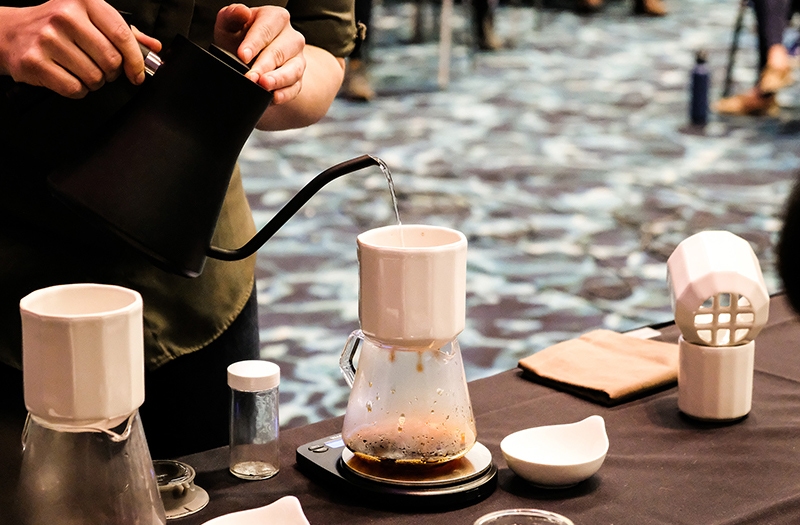
But there are important differences in filter types that will help determine the taste of your coffee. From the types of filter materials, to the shape and size of the filter, and even the ways of enhancing the filter, there are several factors to consider that can greatly influence the result in the cup.
We’ll explore those differences in types of coffee filters so you can brew the best tasting coffee possible.
Coffee Filter Materials
Paper coffee filters
Paper filters are also the easiest to clean up, since you can simply discard the filter with coffee grounds after brewing. However, this makes paper filters more wasteful since each one provides just a single use in brewing. Using a paper filter is also potentially healthier, since the paper most effectively prevents the coffee oils from getting into your cup, reducing the level of cholesterol in your coffee.
Metal coffee filters

Cleaning a metal filter is certainly more of a nuisance than throwing away a paper one. Coffee grounds can become lodged in the mesh, so it requires a clean after each use to ensure no old coffee grounds and oils make their way into your fresh cup. But our Cafiza Espresso Machine Cleaning Powder is a super effective cleaner for eliminating old coffee residue from any surface, and can be used to clean the oils and sediment from a metal filter.
Cloth coffee filters
Like metal filters, cleaning cloth filters is a pain. They should be washed between each brew, but they shouldn’t become too dry or moist. Cloth filters can be used for about 30 brews before the micro-grounds and oils start to affect the taste of the coffee. But they can be used up to 100 brews safely.
Coffee Filter Shapes: Cone vs. Flat-Bottom Filters

With little hard science backing either school of thought, the University of California Davis Coffee Center has attempted to settle the debate with a set of experiments. UC-Davis conducted a series of triangulation tests with expert and non-expert panelists to determine whether there is a difference in the taste of brewed coffee using semi-conical and flat-bottom filter baskets.
In a first look at the results, the answer found in the study is a resounding ‘yes’. The test results from the panelists’ tasting data revealed a statistically significant difference in coffees based on the shape of the brew basket and filter (and an even more impactful difference than a change in grind size). For light-roasted coffees, a cone-shaped basket yielded more citrus, berry and sour flavors, while the flat-bottom filters produced more dried fruit, sweet and floral flavors. For more dark-roasted coffees, cone filters yielded more intense bitterness, while flat-bottom filters yielded more chocolate, coca and woody flavors.
UC-Davis is still investigating why there is a difference between the tastes between the two filter types. The study explained that the filter shape affects the way hot water flows through the bed of coffee grounds, altering the “mass transfer” process by which molecules move from the solid coffee grounds to the liquid. But the university is still conducting research into the topic.
Coffee Filter FAQ
Yes, most coffee professionals recommend pre-wetting your filter. Pre-wetting will remove the papery taste from the brewed coffee. And if manually brewing a pourover coffee, using hot water to pre-wet the filter will also heat your carafe, so it will better retain the temperature of the brewed coffee. However, it’s generally not recommended to pre-wet a filter for an immersion brew.
What’s the difference between white and brown paper filters?
White filters are bleached, while brown filters are not. White typically filters are bleached with a small amount of chlorine, or through oxygen-bleaching. Both methods are safe to use for brewing coffee, and the bleaching process won’t affect the flavors of your drink. However, bleaching is not great for the environment and adds an extra step in the manufacturing process.
What do the numbers on paper filters mean?
These numbers correspond to filter size. Most automatic drip coffee machines recommend a specific filter size depending on the amount of coffee being brewed. Brewing 2-6 cups requires a No. 2 filter, 8-10 cups requires a No. 4 filter, and brewing more than 10 cups requires a No. 6 filter.
Can I reuse a paper filter?
Yes, but this works better with a thicker filter. You can simply discard the used grounds, clean and rinse the filter with water, and let it dry. If you want a filter that can be used for years, it’s worth investing in a metal filter.
With a Chemex filter, should I place the side with three paper folds toward or away from the spout of the brewer?
It should face the spout. This three-layered side is sturdier than a single layer of the filter, so it won’t collapse into the spout. This is important because the spout acts as an air channel during the brewing process, allowing the air from the hot water to escape the brewer.


